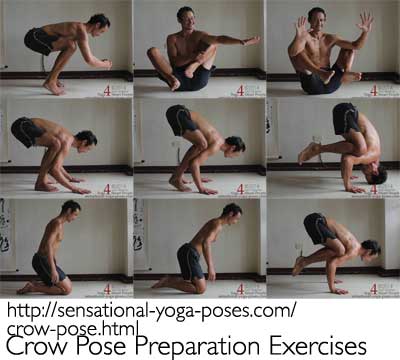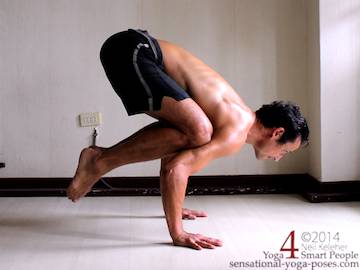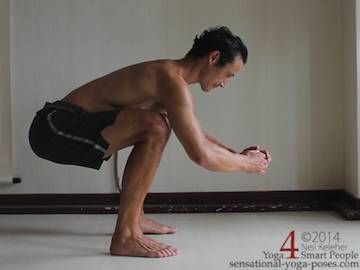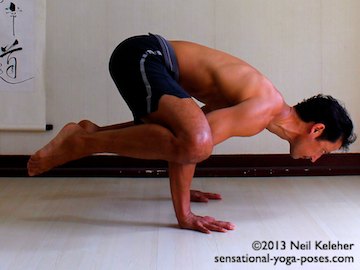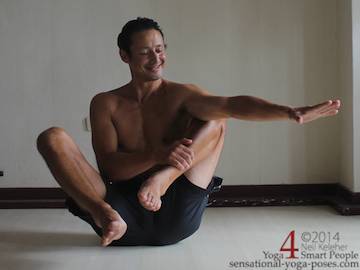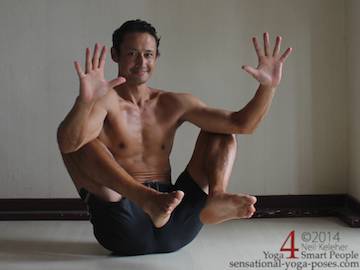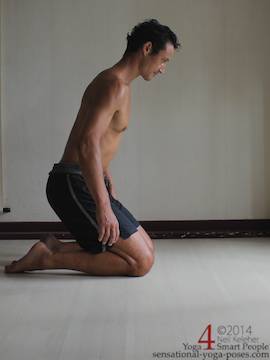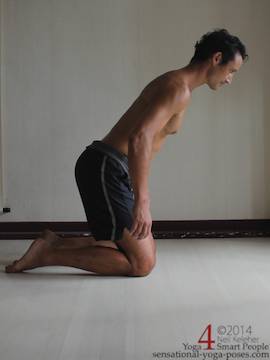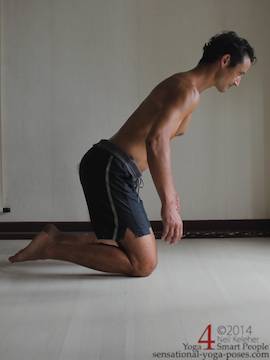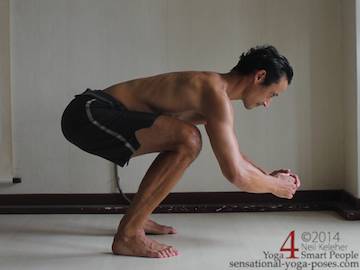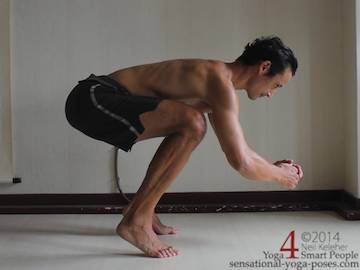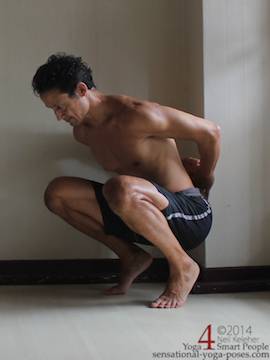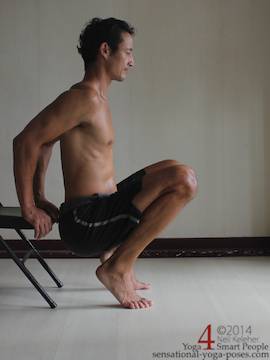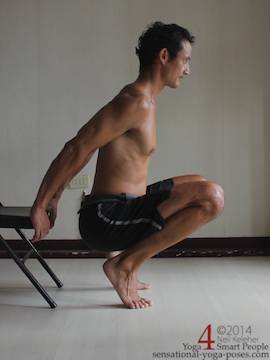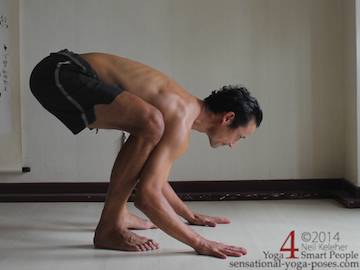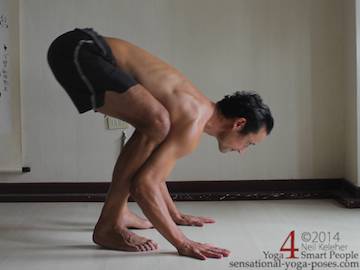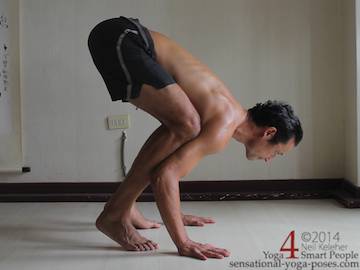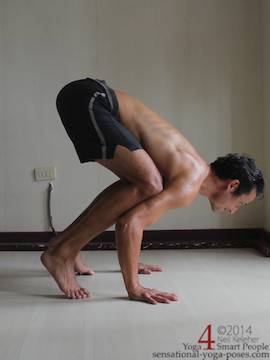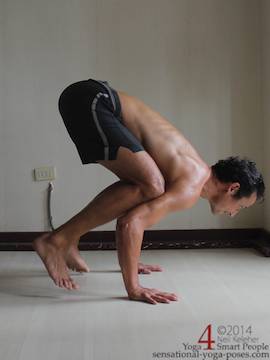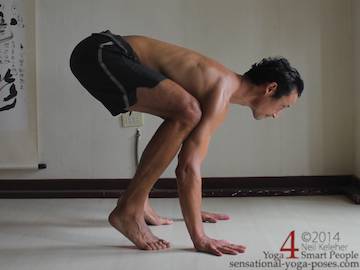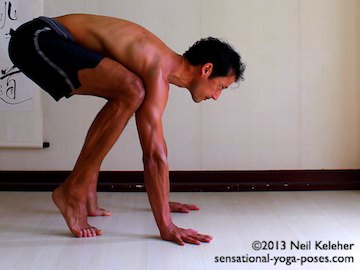Basic Flexibility for Crow Pose
One of the first requirements for doing crow pose arm balance is that you be able to get the upper arms in front of your shins and in addition your torso close to your thighs. (Picture below left).
If you can't do this then an option for crow pose is to rest the inner knees on the points of the elbows. (Picture below right).
To check that you have the required amount of flexibility and also to help get used to the idea that the shins contact the back of the arms you can balance on your butt and try to place one arm in front of the shin on the same side.
Try each side individually then try balancing on your butt with both sides doing the action at the same time.
Wiggle your fingers (magic fingers) to show that you are having fun.
(You could also wiggle your eyebrows.)
Shifting Weight Forwards and Backwards
The next step is learning the weight shift that will help you get into crow pose arm balance.
An easy way to practice this is to kneel with your hips lifted about half way.
Lean your torso forwards. Shift back far enough that you feel the tops of your feet pressing into the floor. Next slowly shift forwards till you feel your weight centered over your knees. Lift your feet slightly. Put them down and shift back.
Repeat this a few times till you get used to feeling your center of gravity moving forwards and backwards and so that you get used to feeling your center of gravity pressing through feet and knees (when it is shifted backwards) and pressing just through your knees (when it is shifted forwards.)
If you are waiting at a bus stop, or waiting for your significant other to get ready, you could practice a similiar exercise while standing with feet parallel.
Rock forwards far enough that your toes and forefeet press down with equal pressure.
Then lift your heels and stay balanced on the fronts of your feet. Then lower your heels and rock back far enough that your heels and forefeet press down with equal pressure.
You don't have to lift heels when rocking forwards.
You could just rock forwards and backwards focusing on the change in pressure sensation in your feet.
Rocking while Squatting
The next step for crow pose arm balance is to move into a squatting position. Feet can be parallel (as in pictures below) or have them turned out but with heels about a fist width apart.
If you can't get your heels on the floor in this position then wedge them with a book or yoga block so that they are supported and so that you can center your weight between heels and forefoot.
If you have your heels on a wedge or on the floor then lift your hips, shift your weight forwards so that your weight is over the fronts of your feet and then lift the heels. Then lower them down and shift your weight back.
If you keep you hips lifted you may find it easier to lower your heels first and then rock back.
Use a Wall or Other Support
One other alternative, squat in front of a wall with your hands on the wall behind you.
Lift your hips about half way gently push away from the wall till you are balanced on the fronts of your feet and your hands can easily leave the wall.
Then hands on the wall return smoothly to the starting position.
Rocking into Yoga Crow Pose Arm Balance
Next place your hands on the floor in front of your shins. Have the feet and knees turned out so that the knees are wider than your torso. Have your heels about a fist width apart. this is so that the shins angle up and outwards.
Place your hands on the floor about shoulder width apart with the elbows pointing back.
With weight on your legs place your shins against the backs of your upper arms, or slide the hands back until your upper arms touch the fronts of your shins.
Lift your pelvis then shift your weight forwards.
As you do so notice the increase in pressure of your legs against your arms. Shift your weight back and notice the pressure decrease.
Repeat this a few times moving slowly and smoothly, rhythmically.
Shift your weight further forwards and notice an increase in pressure in the hands and a reduction of pressure in the feet.
Rock back and notice the reduction in hand pressure.
Repeat this a few times.
One trick that sometimes works for me in getting my feet off of the floor effortlessly in crow pose is rocking forwards and trying to maximize pressure of the legs on my arms.
Maximal pressure means that the feet aren't bearing any pressure and so they can lift.
Another sensitivity exercise is to rock forwards far enough that your feet feel lightly while your hands press down with maximum pressure. You should then be able to lift your feet.
Problems with Crow Pose
(And Entering Crow from Tripod Headstand)
One problem some students have is that as soon as they lift their feet they fall back.
A similiar problem can be had entering crow pose from tripod headstand. A student will shift their weight onto their hands then as they lift their head they are still shifting their weight backwards so that they end up on their feet again.
The key in both situations is to keep your center over your hands.
- Moving from headstand to crow pose arm balance, as soon as you feel your weight on your hands keep it there. Root through the fingers and as you lift your head keep your weight forwards enough that your fingers continue to press into the floor.
- Shifting forwards into crow pose, feel your fingers pressing down and keep them pressing down as you lift your feet.
Look Forwards in Crow Pose
A key point when moving into crow pose (from the squat) is to look forwards.
If you look back your head will be pulled down and you may find that you actually end up doing a forward roll. If you look forwards (and slightly down) your head will lift. And if you reach forwards with your gaze your head will actually reach far enough forwards to act as a counterweight meaning that you might not have to shift quite as far forwards to find balance.
Try Bending Your Spine Forwards
Some people have a relatively long torso (or relatively shorter legs).
The tendency then is for the pelvis to lift very high.
In these cases you may find it helps to focus on bending the lumbar spine and thoracic spine forwards using the abs instead of keeping the spine straight.
Lifting the Pelvis Higher?
In general, the higher you lift the pelvis, the wobblier the pose will feel. However because the center of gravity is higher, (as opposed to further back) you may find that you don't have to move quite so far forwards to lift your feet.
My Arms are Too Weak!
Once you rest your shins on the backs of the arms, the work of the arms is less because the muscles of the arms, shoulder and chest don't have to support so much weight.
Instead the bony structure of the arms is supporting the weight of the legs and pelvis.
As such it should be easier to do this pose with the elbows bent as opposed to say, chaturanga dandasana. and this too can have an affect on getting your feet off of the floor.
With elbows bent you bring your head and shoulders closer to the floor. You may find that you then don't have to reach your body so far forwards to get to the balance point.
Working Towards Crow Pose with Straight Elbows
How do you work towards a straight arm version of Crow Pose?
One key is to get the knees as high up the arms as possible. Since you won't be using the upper arms as a shelf, try to pinch some muscles between the knee. Position the knees towards the outside of the upper arms then pinch them in grabbing some flesh as you do so. See if you can pinch the flesh in such a way that it resists the inwards push of the knees.
You can start in the bent arm version of crow pose and then try to straighten the arms keeping balanced as you do so.
Another option is to start with the elbows straight. Lift the heels so it is easier to get your knees to the backs of your upper arms as high as possible. Then lift the hips high.
Make the elbows strong (muscularly brace them) and press the knees into the arms until you can take your feet off of the floor.
Jumping Back Lightly from Crow Pose
To jump back from bakasana/crow pose arm balance and land lightly in chaturanga dandasana, keep your weight forwards for as long as possible while you jump.
Think of reaching your shoulders, chest and head forwards, further ahead of your hands as your kick your legs back.
Towards the end you'll run out of room and probably have to shift back.
Or you can cheat and land your feet while your center is still over your hands then slight the feet back till you are in the desired chaturanga position.
Regardless, the longer you keep your center over your hands the lighter you can jump back into chaturanga without a loud thumping sound.
To progress towards this gradually start with short hops keeping your center over your hands and gradually work at moving your feet further and further back.
From Crow Pose to Handstand?
One Possible Progression
Currently I don't have the ability to move from bakasana into handstand but at a guess I would say the important part is learning to brace arms, shoulders and torso prior to lifting the knees off of the arms. A weight shift may be involved also. You may have to shift your body forwards as you brace your arms and torso and as you reduce contact pressure between knees and arms.
As a suggestion, if you can't lift into handstand with knees bent and together, then start by first lowering the knees legs from handstand while bending the knees, and then lifting them back up again. From there see if you can lower from handstand into bakasana. Then work at lowering to the bakasana position without pressuring the connection between legs and arms, then lift back up again. Then work at pressuring the connection, depressurizing it and lifting up.
Published: 2012 05 28
